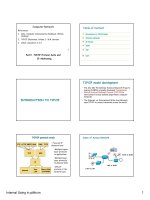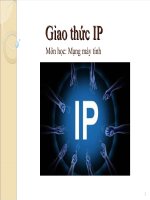TCP IP PROTOCOL SUITE AND IP ADDRESSING (p1) (MẠNG máy TÍNH cơ bản SLIDE)
Bạn đang xem bản rút gọn của tài liệu. Xem và tải ngay bản đầy đủ của tài liệu tại đây (1.74 MB, 86 trang )
Chapter 9
TCP/IP PROTOCOL SUITE
AND IP ADDRESSING
Overview
• Internet based on the TCP/IP protocol
suite. The design of TCP/IP is ideal for
the decentralized and robust network
that is the Internet. Many protocols
used today were designed using the
four-layer TCP/IP model.
Bài Giảng Mạng Máy Tính
1
• It is useful to know both the TCP/IP and
OSI networking models. Each model
offers its own structure for explaining
how a network works but there is much
overlap between the two. Without an
understanding of both, a system
administrator may not have sufficient
insight into why a network functions
the way it does.
Bài Giảng Mạng Máy Tính
2
• Any device on the Internet that wants
to communicate with other Internet
devices must have a unique identifier.
The identifier is known as the IP
address because routers use a layer
three protocol, the IP protocol, to find
the best route to that device. IPv4, the
current version of IP, was designed
before there was a large demand for
addresses.
Bài Giảng Mạng Máy Tính
3
• Explosive growth of the Internet has
threatened to deplete the supply of IP
addresses. Subnetting, Network Address
Translation (NAT) and private addressing
are used to extend IP addressing without
exhausting the supply. Another version
of IP known as IPv6 improves on the
current version providing a much larger
address space, integrating or eliminating
the methods used to work with the
shortcomings of IPv4.
Bài Giảng Mạng Máy Tính
4
• In addition to the physical MAC address,
each computer needs a unique IP
address, sometimes called logical
address, to be part of the Internet. There
are several methods of assigning an IP
address to a device. Some devices
always have a static address, while
others have a temporary address
assigned to them every time they
connect to the network. When a
dynamically assigned IP address is
needed, the device can obtain it using
several methods.
Bài Giảng Mạng Máy Tính
5
• For efficient routing to occur between
devices, other issues must be resolved.
For example, duplicate IP addresses can
stop efficient routing of data.
• Students completing this module
should be able to:
– Explain why the Internet was developed and how
TCP/IP fits the design of the Internet.
– List the four layers of the TCP/IP model.
– Describe the functions of each layer of the TCP/IP
model.
– Compare the OSI model and the TCP/IP model.
Bài Giảng Mạng Máy Tính
6
– Describe the function and structure of IP
addresses.
– Understand why subnetting is necessary.
– Explain the difference between public and private
addressing.
– Understand the function of reserved IP addresses.
– Explain the use of static and dynamic addressing
for a device.
– Understand how dynamic addressing can be done
using RARP, BootP and DHCP.
– Use ARP to obtain the MAC address to send a
packet to another device.
– Understand the issues related to addressing
between networks.
Bài Giảng Mạng Máy Tính
7
9.1. Introduction to TCP/IP
• The TCP/IP model has four layers: the
application
layer,
transport
layer,
Internet layer, and the network access
layer. Some of the layers in the TCP/IP
model have the same name as layers in
the OSI model. It is critical not to
confuse the layer functions of the two
models because the layers include
different functions in each model.
Bài Giảng Mạng Máy Tính
8
Bài Giảng Mạng Máy Tính
9
• The present version of TCP/IP was
standardized in September of 1981. As
shown in the figure, IPv4 addresses are
32 bits long, written in dotted decimal,
and separated by periods. IPv6
addresses are 128 bits long, written in
hexadecimal, and separated by colons.
Colons separate 16-bit fields. Leading
zeros can be omitted in each field as
can be seen in the figure where the field
:0003: is written :3:.
Bài Giảng Mạng Máy Tính
10
• In 1992 the standardization of a new
generation of IP, often called IPng, was
supported by the Internet Engineering
Task Force (IETF). IPng is now known
as IPv6. IPv6 has not gained wide
implementation, but it has been
released
by
most
vendors
of
networking
equipment
and
will
eventually become the dominant
standard.
Bài Giảng Mạng Máy Tính
11
Bài Giảng Mạng Máy Tính
12
9.1.2. Application Layer
• The application layer of the TCP/IP model
handles high-level protocols, issues of
representation, encoding, and dialog
control. The TCP/IP protocol suite
combines all application related issues
into one layer and assures this data is
properly packaged before passing it on to
the next layer. TCP/IP includes not only
Internet
and
transport
layer
specifications, such as IP and TCP, but
also
specifications
for
common
applications.
Bài Giảng Mạng Máy Tính
13
Bài Giảng Mạng Máy Tính
14
• TCP/IP has protocols to support file
transfer, e-mail, and remote login, in
addition to the following applications:
– File Transfer Protocol (FTP) – FTP is a
reliable, connection-oriented service
that uses TCP to transfer files
between systems that support FTP. It
supports bi-directional binary file and
ASCII file transfers.
Bài Giảng Mạng Máy Tính
15
– Trivial File Transfer Protocol (TFTP) –
TFTP is a connectionless service that
uses the User Datagram Protocol
(UDP). TFTP is used on the router to
transfer configuration files and Cisco
IOS images, and to transfer files
between systems that support TFTP.
It is useful in some LANs because it
operates faster than FTP in a stable
environment.
Bài Giảng Mạng Máy Tính
16
– Network File System (NFS) – NFS is a
distributed file system protocol suite
developed by Sun Microsystems that
allows file access to a remote storage
device such as a hard disk across a
network.
– Simple Mail Transfer Protocol (SMTP) –
SMTP administers the transmission of
e-mail over computer networks. It does
not provide support for transmission
of data other than plaintext.
Bài Giảng Mạng Máy Tính
17
– Terminal emulation (Telnet) – Telnet provides the
capability to remotely access another computer. It
enables a user to log in to an Internet host and
execute commands. A Telnet client is referred to
as a local host. A Telnet server is referred to as a
remote host.
– Simple Network Management Protocol (SNMP) –
SNMP is a protocol that provides a way to monitor
and control network devices, and to manage
configurations, statistics collection, performance,
and security.
– Domain Name System (DNS) – DNS is a system
used on the Internet for translating names of
domains and their publicly advertised network
nodes into IP addresses.
Bài Giảng Mạng Máy Tính
18
9.1.3. Transport layer
• The transport layer provides transport
services from the source host to the
destination host. The transport layer
constitutes a logical connection between
the endpoints of the network, the sending
host and the receiving host. Transport
protocols segment and reassemble
upper-layer applications into the same
data stream between endpoints. The
transport layer data stream provides endto-end transport services.
Bài Giảng Mạng Máy Tính
19
Bài Giảng Mạng Máy Tính
20
• The Internet is often represented by a
cloud. The transport layer sends data
packets from the sending source to the
receiving destination through the cloud.
End-to-end control, provided by sliding
windows and reliability in sequencing
numbers and acknowledgments, is the
primary duty of the transport layer when
using TCP. The transport layer also
defines
end-to-end
connectivity
between host applications. Transport
services include all the following
services:
Bài Giảng Mạng Máy Tính
21
• TCP and UDP
– Segmenting upper-layer application
data
– Sending segments from one end device
to another end device
• TCP only
– Establishing end-to-end operations
– Flow control provided by sliding
windows
– Reliability
provided
by
sequence
numbers and acknowledgments
Bài Giảng Mạng Máy Tính
22
Bài Giảng Mạng Máy Tính
23
9.1.4. Lớp Internet
• The purpose of the Internet layer is to
select the best path through the
network for packets to travel. The main
protocol that functions at this layer is
the Internet Protocol (IP). Best path
determination and packet switching
occur at this layer
Bài Giảng Mạng Máy Tính
24
Bài Giảng Mạng Máy Tính
25









